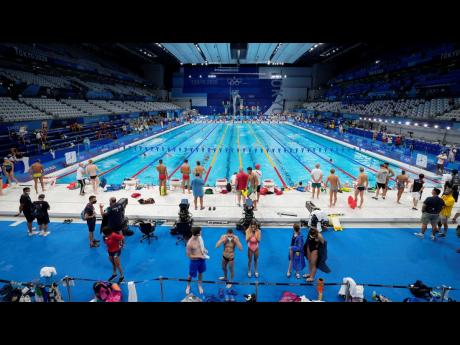Swimming warm-up can be a chaotic ‘nightmare’
TOKYO (AP):
Cate Campbell was a 17-year-old swimming phenomenon when she learned the dangers of warm-up at major competitions the hard way.
That is what a head-on collision with Michael Phelps will do for you.
“He was doing a sprint butterfly down the wrong side of the lane. Straight into me doing backstroke,” Campbell recalled about the incident at the 2009 World Championships in Rome. “There was a lot of velocity and power in that. He swims really fast, apparently.”
Campbell came away with three vertebrae compacted in her neck - which was rendered practically immobile - and a big lump on her head.
Now entering her fourth Olympics with five medals to her name, Campbell knows the most important rule of warm-up.
“Everyone for themselves,” she said in a recent interview. “Sometimes it is honestly a nightmare. … You’re touching the people in front of you, their feet and someone’s touching your feet. Everyone’s swimming over the breaststrokers, who are a real hazard.”
With hundreds of swimmers scrambling to get their warm-up done at the same time, multiple athletes in each lane, everyone diving over one another and some competitors using snorkels, kickboards and other paraphernalia, warm-up is organised chaos.
Amid a pandemic, warm-up could be considered a health hazard.
“At this point, we’ve gotten comfortable being in a large crowd,” said American swimmer Zach Harting, who will race the 200-metre butterfly. “I’m vaccinated, so that provides a little bit of comfort there. I’m not worried about it. It’ll be fun. If not, we’ll leave. That’s my motto.”
While it is not a rule that is strictly enforced, swimming’s governing body FINA suggests that only the athletes competing each morning or evening warm up in the competition pool in the 90 minutes before each session. Other swimmers can go to a nearby warm-up pool - which is usually just as chaotic.
In today’s opening swimming session, there are 26 different heats in six different events, including the women’s 4x100-metre freestyle relay. That could amount to nearly 300 swimmers warming up at once.
Overall, there are nearly 1,000 swimmers at the Tokyo Games from nearly 200 countries.
“You can’t be telling people that they can’t warm up,” said Bronte Campbell, Cate’s younger sister and a member of Australia’s heavily favoured 4x100 free relay team.
“They’re going to do their best to keep everyone safe, and we all want to keep each other safe,” she added. “But the warm-up pool is going to be a very interesting space this time around.”
The warm-up pool was also in the spotlight at the 2015 World Championships in Kazan, Russia, when Sun Yang of China got into a confrontation with a female Brazilian swimmer then failed to show up for the 1,500 free final as reigning champion.
“It’s quite chaotic,” said Chad le Clos, a four-time Olympic medallist from South Africa. “I’ve been jumped on a few times. I’ve jumped on people a few times. Because obviously the first lane is the diving lane. But sometimes if people go quickly under the lane you don’t see it.”
Problems arise depending on which side of the lane is used for which direction. And while Australians stay left at home, they fall in line with the rest of the world at major meets, the Campbells said.
“I was on the right side of the lane and (Phelps) was on the wrong side of the lane,” Cate Campbell said of that 2009 collision. “So we’ll hand over the blame to him.”

